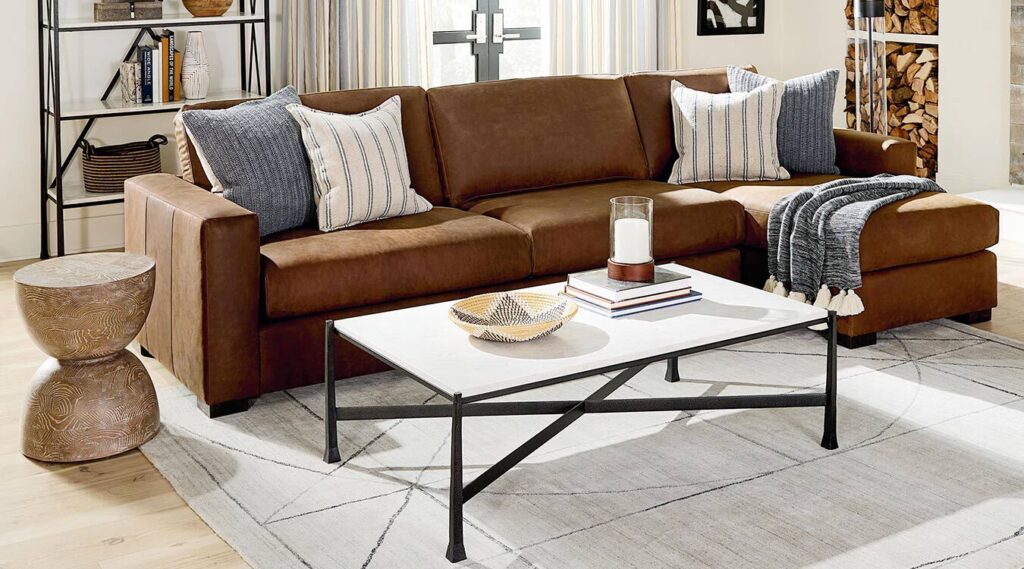Understanding the Importance of Leather Sofa Maintenance
A leather sofa is not just a piece of furniture; it is an investment that adds both style and comfort to your living space. Proper maintenance is crucial for preserving the elegance and functionality of your leather sofa over time. While leather is known for its durability, it can still be prone to damage if not cared for adequately. Understanding how to maintain your leather sofa will help you prolong its lifespan and keep it looking new for years to come.
The Lifespan of a Well-Maintained Leather Sofa
The lifespan of best leather sofas largely depends on how well it is maintained. High-quality leather, when properly cared for, can last anywhere from 15 to 20 years or even longer. Regular care, including routine cleaning and conditioning, can prevent the leather from drying out, cracking, or developing unsightly blemishes. In contrast, neglecting maintenance could result in a significant reduction in its lifespan, diminishing its appeal and comfort.
Additionally, a well-maintained leather sofa holds its value better than one that has been poorly cared for. Should you ever decide to sell your leather sofa, potential buyers will certainly appreciate a piece that has been kept in great condition, making it easier to negotiate a favorable price. The resale value can be a reflection of not just the quality of the leather but also the care it has received over the years, which can be a significant factor in your investment return.

The Impact of Regular Care on Sofa Appearance
Regular care and maintenance greatly affect the appearance of your leather sofa. Leather is a natural material that can absorb dirt, oils, and moisture from the air and our skin. Without proper cleaning routines, the sofa can become dull and lifeless, leading to a faded appearance over time. Regular cleaning not only removes these contaminants but also helps to restore the natural shine of the leather.
Furthermore, conditioning your leather sofa with suitable products will keep it supple and glossy. This prevents the leather from becoming stiff or developing cracks. The visual appeal of a well-cared-for sofa significantly enhances your space and reflects your attention to detail and care in your home environment. Moreover, the tactile experience of a soft, well-maintained leather surface adds to the comfort of your living area, inviting you and your guests to relax and enjoy the ambiance of your home.
In addition to cleaning and conditioning, it is also essential to protect your leather sofa from direct sunlight and heat sources. Prolonged exposure can lead to fading and drying out of the leather, which can compromise its integrity. Utilizing window treatments or strategically placing your sofa away from windows can help mitigate these risks. By being mindful of the environment in which your leather sofa resides, you can further enhance its longevity and visual appeal, ensuring it remains a centerpiece of your home for years to come.
Essential Tools for Leather Sofa Care
Having the right tools at your disposal is essential for the effective maintenance of your leather sofa. Investing in quality products specifically designed for leather care will ensure that your sofa receives the best treatment possible, preserving both its function and appearance.
Cleaning Products for Leather Sofas
When it comes to cleaning products, it is crucial to choose items that are pH-balanced and free from harsh chemicals or abrasive materials that can damage the leather. Look for gentle leather cleaners that are effective at removing dirt and grime while being safe for use on treated leather.
Additionally, using a leather conditioner will help to nourish the material, keeping it moisturized and preventing drying and cracking. Aim to perform routine cleaning with these products at least once a month, or more frequently for high-traffic sofas. Regular maintenance not only enhances the visual appeal of your leather sofa but also extends its lifespan, allowing you to enjoy its beauty for years to come. Consider incorporating a deep cleaning routine every six months, which may involve more intensive products designed to penetrate and lift embedded dirt. Click here to learn more about the effectiveness of products.
Protective Gear for Leather Maintenance
While cleaning your leather sofa, consider using protective gear to safeguard the leather. A soft, microfiber cloth should be your primary tool for both cleaning and conditioning, as it will not scratch the surface. You might also want to wear cotton gloves while working on the sofa to prevent transferring oils from your hands to the leather.
If your leather sofa is positioned in an area where it is exposed to sunlight, investing in a UV protectant specifically for leather can also help to shield it from fading or drying out in direct light. Furthermore, placing your sofa away from heat sources, such as radiators or fireplaces, can prevent the leather from becoming brittle over time. Together, these protective gear and tools create an effective maintenance toolkit for your leather sofa, ensuring that it remains a stunning centerpiece in your living space. Additionally, consider using coasters and throws to protect against spills and wear, which can be particularly beneficial in homes with children or pets.
Routine Cleaning and Maintenance Tips
To keep your leather sofa looking its best, establishing a routine cleaning and maintenance schedule is vital. Incorporating both daily habits and deep-cleaning techniques can significantly extend the life and beauty of your sofa.
Daily and Weekly Cleaning Habits
As part of your daily routine, take a moment to remove any debris or crumbs from the seating surface of your sofa. You can use a soft-bristle brush or a vacuum with a soft attachment to carefully eliminate dirt and prevent buildup. On a weekly basis, it’s advisable to wipe down the leather surfaces with a damp cloth to remove any lingering dust or oils.
Furthermore, regularly re-evaluating the positioning of your sofa can help in preventing damage. Ensure that it is not directly in front of heat sources or windows that receive a lot of sunlight, as prolonged exposure can lead to fading and deterioration. Additionally, consider using window treatments or UV-blocking films to protect your sofa from harmful rays while still allowing natural light to brighten your space.
Monthly Deep-Cleaning Techniques
About once a month or more often if necessary, perform a more thorough cleaning of your leather sofa. Start by using a designated leather cleaner to gently clean the entire surface followed by a thorough application of leather conditioner. Conditioning not only revitalizes the leather but also acts as a protective barrier against spills and stains. Make sure to apply it evenly and allow adequate time for it to dry before using the sofa again.
Additionally, don’t forget to check the seams and stitching for any signs of wear or damage. Addressing minor issues promptly can prevent more significant repairs down the line. It’s also wise to keep an eye out for any changes in texture or color that might indicate the leather is drying out or becoming brittle. If you notice any such changes, consider adjusting your cleaning routine or using a more intensive conditioning treatment to restore its luster.
Moreover, consider the environment in which your leather sofa resides. High humidity can lead to mold growth, while overly dry conditions can cause the leather to crack. Using a humidifier or dehumidifier can help maintain an optimal atmosphere for your furniture. Regularly inspecting the area around your sofa for spills or accidents is also crucial; immediate attention to any stains can make a significant difference in maintaining the integrity of the leather. Read more about removing stains from leather sofas at https://blogs.extension.iastate.edu/answerline/2018/06/18/sunscreen-stains-on-leather/
Dealing with Stains and Spills on Leather
Despite your best efforts, spills and stains can happen on your leather sofa. Understanding how to tackle these incidents promptly is essential for keeping your sofa in pristine condition.
Immediate Action for Fresh Spills
When a fresh spill occurs, immediate action is crucial. Begin by blotting the area with a clean, absorbent cloth to soak up as much liquid as possible. Avoid rubbing, as this can push the liquid deeper into the leather. Depending on the type of spill, you may use a mild soap solution to clean the affected area; however, test any solution on a hidden area first to ensure it doesn’t affect the leather’s appearance.
Once the area is clean, proceed to dry it thoroughly and apply a leather conditioner to restore moisture. Quick action can mean the difference between a minor cleanup and a more complicated stain removal process.
Removing Old or Stubborn Stains
For old or stubborn stains, you may need to employ different methods. Start by gently scrubbing the stain with a damp cloth and a small amount of leather cleaner. If the stain persists, you might consider seeking professional cleaning services specialized in leather upholstery. They have the tools and knowledge to resolve stubborn stains without damaging the leather.
If you prefer a DIY approach, combining equal parts vinegar and olive oil can sometimes do wonders. Apply the mixture sparingly with a cloth, and always remember to condition the leather after any cleaning method.

Preventing Damage to Your Leather Sofa
While cleaning and care are crucial for maintaining your leather sofa, taking steps to prevent damage in the first place is equally important. Simple precautions can protect your investment long-term and enhance its durability.
Protecting Leather from Sunlight and Heat
Direct sunlight can be one of the most damaging factors to leather. To protect your sofa, consider positioning it away from windows or using curtains and shades to filter sunlight. If your furniture is situated in a sunlit area, using UV protectant sprays can help mitigate fading and cracking over time.
Additionally, avoid placing your leather sofa near heat sources like radiators or fireplaces. Excessive heat can dry out the leather, leading to a loss of softness and suppleness. Ideally, maintain a stable room temperature to keep the leather in optimal condition.
Avoiding Harmful Cleaning Products
Lastly, it is vital to avoid using abrasive or harsh cleaning products on your leather sofa. Common household cleaners, bleach, or ammonia-based products can severely damage the leather’s finish. Always opt for specialized leather care products designed specifically for the type and finish of your sofa.
By adhering to these maintenance tips and practices, you can ensure that your leather sofa retains its elegance and charm for years to come, exemplifying style and comfort in your living area.
